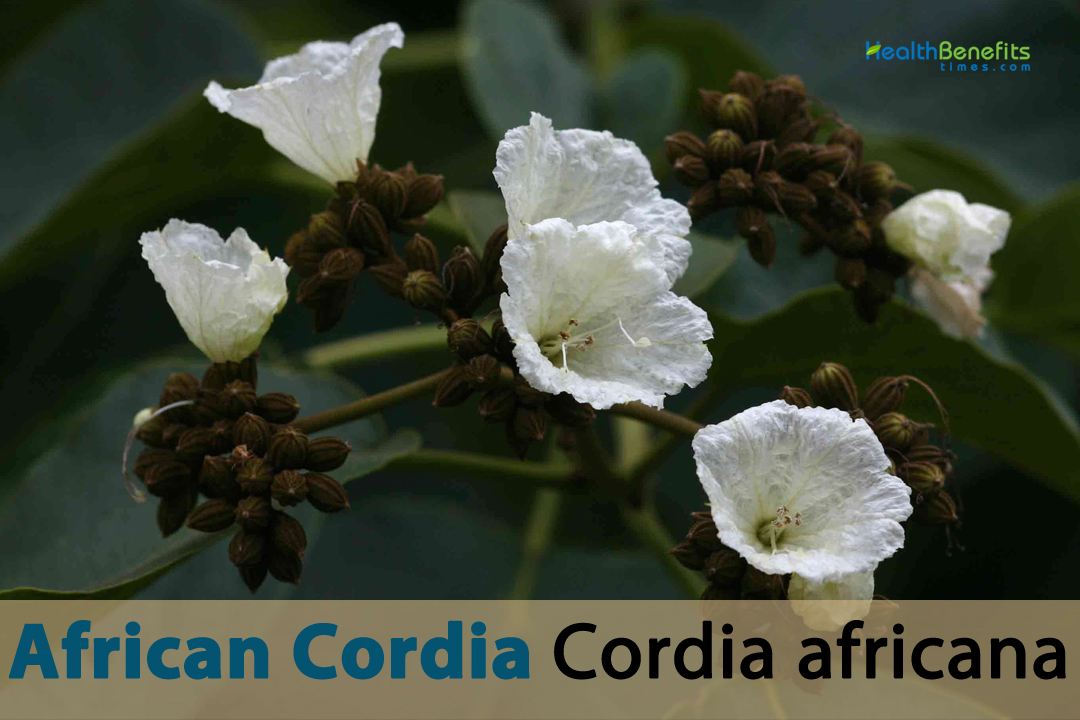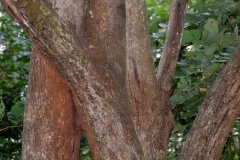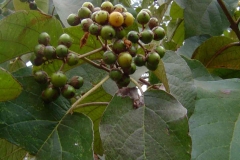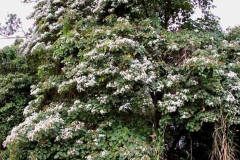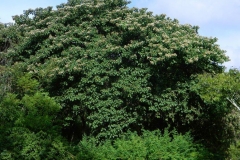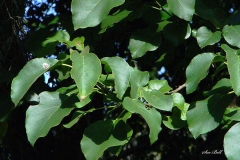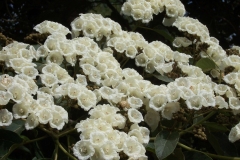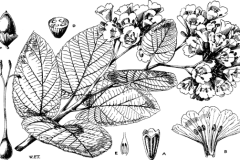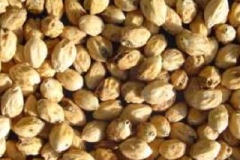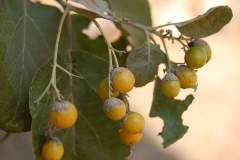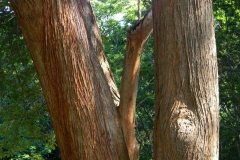| African Cordia Quick Facts | |
|---|---|
| Name: | African Cordia |
| Scientific Name: | Cordia africana |
| Origin | Africa, primarily in East Africa and parts of West Africa |
| Colors | Green when young, yellow to orange when mature |
| Shapes | Small, round to slightly oval in shape about 1 to 2 cm in diameter |
| Flesh colors | Yellow to orange |
| Taste | Sweet and mildly fruity |
| Major nutrients | • Fats • Proteins • Fiber • Vitamin A • Vitamin C • Vitamin B1 (thiamine) • Vitamin B2 (riboflavin) • Calcium • Iron • Magnesium • Phosphorus • Potassium • Antioxidants • Calories |
| Health benefits | Treats diarrhea, amoebiasis, asthma, wheezing, tuberculosis, fatigue, jaundice, schistosomiasis, headaches, nosebleeds and vertigo |
| Name | African Cordia |
|---|---|
| Scientific Name | Cordia africana |
| Native | Africa, primarily in East Africa and parts of West Africa. It is commonly found in countries such as Ethiopia, Kenya, Tanzania, Uganda, Sudan, South Sudan, Rwanda, Burundi, Democratic Republic of the Congo (DRC), Zambia, Malawi, Mozambique, Zimbabwe, Angola |
| Common Names | Ironwood Cordia, African Cordia, East Coast Cordia, Umbrella Thorn, East African Cordia, African Cordia Tree, Red Cordia, African Cordia Bush, Ethiopian Cordia, Ethiopian Cherry, Thorny Cordia, Sand Cordia, Wild Cordia |
| Name in Other Languages | Afrikaans: Afrikaanse Cordia, Grootblaar pieringbessie Amazigh: Tagaḍt Ambo: Muhongele Amharic: Zigi, Aerbat (ዓረብተር), Baburyan (ባቡርያን),waniza (ዋንዛ) Arabic: Cordia Afriqiya (كورديا أفريقية), sibistan ‘afriqiun (سبستان أفريقي) Assamese: African Cordia (আফ্ৰিকান কৰ্ডিয়া) Bengali: Āphrikāna karḍiẏā (আফ্রিকান কর্ডিয়া) Chinese: Fēizhōu kēdíyà (非洲科迪亚), Fēizhōu tǎnsōng (非洲坦松) Czech: Afričan Cordia Danish: Afrikansk Cordia Dutch: Afrikaanse Cordia English: African Cordia, white manjack, Large-leaved cordia, Large-leaved saucer-berry, East African cordia, Large leaf cordia, Sudan teak, White manjack Filipino: Cordia ng Aprika Finnish: Afrikkalainen Cordia, Karhepuu, afrikankarhepuu French: Cordia africaine, Bois de Gagnep, teck d’Arabie, Faux teck, Sébestier d’Afrique, Sébestier d’Afrique à larges feuilles, Teck d’Arabie Georgian: Apirikuli Kordia (აფრიკული კორდია) German: Afrikanische Cordia Gikuyu: Mtondoo Greek: Afrikaniki Kórdia (Αφρικανική Κόρντια) Gujarati: Āphrikan kōrḍiyā (આફ્રિકન કોર્ડિયા) Hausa: Gwanda, Bambami, Ganye, Alilliba Hebrew: Kordia Afriknit (קורדיה אפריקנית), ונזה Hindi: Aphreeki Kordia (अफ्रीकी कोर्डिया) Hungarian: Afrikai Cordia Igbo: Ola-ndigbo, Ona Italian: Cordia Africana Japanese: Afurika korudia (アフリカコルディア), Afurikan korudia (アフリカンコルディア), Korudia afurikāna (コルディア・アフリカーナ) Kannada: Āphrikən korḍiyā (ಆಫ್ರಿಕನ್ ಕೊರ್ಡಿಯಾ) Kashmiri: African Cordia (افریکن کورڈیا) Kenya: Akaiyo, chibulukwa, kumukihili, mugunguret, mukamari, muringa, omokobokobo, samutet, wandesi Kikuyu: Mutangula, muringa Kinyarwanda: Umukungu, Umugonzi, Umuvugangoma, Mgoma, Mofoka, Muvukangoma Konkani: African Cordia (आफ्रिकन कोर्डिया) Korean: Apeurika koreudia (아프리카 코르디아), Apeurikan kodia (아프리칸 코디아) Luba–Katanga: Lombasoko Luganda: Musalu Maithili: African Cordia (अफ्रिकन कोर्डिया) Malay: Cordia Afrika Malayalam: Afrikkan kordiya (ആഫ്രിക്കൻ കോർഡിയ) Marathi: Aphrikan kordiya (अफ्रिकन कॉर्डिया) Nepali: Aphrikan kordiya (अफ्रिकन कोर्डिया) Norwegian: Afrikansk Cordia Odia: African Cordia (ଆଫ୍ରିକାନ କୋର୍ଡିଆ) Oromo: Udaa, Eekku Persian: Kordia Afrikayi (کردیا آفریقایی) Portuguese: Cordia Africana, cordia-da-abissínia Punjabi: Aphrikī Kordia (ਅਫਰੀਕੀ ਕੋਰਡੀਆ) Romanian: Cordia Africană Rundi: Umukungu, Umuvugangamwa, Umuvugangoma Russian: Afrikanskaya kordiya (Африканская кордия) Sanskrit: African Cordia (अफ्रीकन कोर्डिया) Sindhi: African Cordia (افریکن ڪورڊيا) Sinhala: Afrikān korḍiyā (ඇෆ්රිකාන් කොර්ඩියා) Somali: Cagarro, Geed Faadh South Africa: Grootblaarpieringbessie Spanish: Cordia Africana Sukuma: Mpumambe Swahili: Mkorosho wa Afrika, Mkungu, Mkungu Mweupe, Muhuje, Muhugu, Mtondoo, Makobokobo, Mringamringa, Muringa Swazi: Ligoba leAfrica Swedish: Afrikansk Cordia Taita: Mutohwe Tamil: Āpirikka kōrṭiyā (ஆபிரிக்க கோர்டியா) Telugu: Āphrikən kārḍiyā (ఆఫ్రికన్ కార్డియా) Thai: Khorîdexīyæ Ēphrikā (คอร์เดียแอฟริกา), Phêū̀ch sa phān āfrịkā (พืชสะพานอาฟริกา) Tigrigna: Zigti Tigrinya: Ararat Turkish: Afrika Cordia Ukrainian: Africanskaya Kordiya (Африканська Кордія) Urdu: Afreeqi Kordia (افریقی کورڈیا), African Cordia (افریکن کورڈیا) Vietnamese: Cordia Châu Phi, Cây Cordia Châu Phi Yao: Mkukuti Yoruba: Eru, Eso-Ori, Igi Irosun Zaramo: Mputi Zulu: Umthathi, Umthombothi, I-Cordia ye-Afrika, Uligoba lweAfrica |
| Plant Growth Habit | Small to medium-sized white flowered, well branched, deciduous evergreen tree |
| Growing Climates | Dry and moist woodlands, savannas, arid and semi-arid regions, riverbanks, in riparian zones, hillsides, slopes, lowland, highland elevations, open grasslands, rocky and hilly terrain, agricultural fields, roadsides, pastureland, along stream banks |
| Soil | Grow in a variety of soil types, including sandy, loamy, and clayey soils. It prefers well-drained soils but can tolerate temporary waterlogging |
| Plant Size | 10 – 30 meters (33- 98 feet) or more tall |
| Root | Root system of Cordia africana consists of both primary and secondary roots |
| Stem | Stems are cylindrical, woody, and erect |
| Bark | Usually grayish-brown, and is smooth in young trees becoming rougher and longitudinally fissured, developing shallow to deep cracks as it ages |
| Leaf | Leaves are leathery, simple, ovate and arranged alternately along the stems, about 7.5-17.5 cm long and 3.5-10.2 cm wide with a dark green upper surface and a paler green and velvety underside |
| Flowering season | April to June |
| Pollinators |
|
| Flower | Bisexual flowers are white and sweetly scented, calyx is ribbed and is less than 1 cm long, and the lobes are covered with short, soft, brown hairs. The corolla is funnel-shaped, crinkled, long exserted and approximately 2.5 cm in length |
| Fruit Shape & Size | Typically small, round to slightly oval in shape about 1 to 2 cm (0.4 to 0.8 inches) in diameter and resemble tiny mangoes in appearance |
| Fruit Color | Green when young, yellow to orange when mature |
| Fruit skin | Thin and smooth to slightly rough or textured |
| Fruit Pulp | Typically juicy and may have a sweet and slightly tangy flavor |
| Fruit Weight | Around 10-20 grams each |
| Flesh Color | Vary in color, ranging from yellow to orange, depending on the ripeness of the fruit |
| Seed | Typically small, slightly oval or elongated, smooth and light brown in color |
| Flavor/Aroma | Sweet and pleasant |
| Taste | Sweet and mildly fruity |
| Plant Parts Used | Leaves, bark, roots, fruits |
| Propagation | By seeds, semi-hardwood cuttings and Air Layering |
| Lifespan | Several decades or even longer under suitable growing conditions |
| Season | August to October |
| Major Nutrition |
|
| Available Forms |
|
Plant Description
African Cordia is a small to medium-sized deciduous evergreen tree with well-branched, white-flowered branches and a rounded, umbrella-shaped, or spreading canopy that provides ample shelter. Aiming for a height of 10 to 30 meters (33 to 98 feet) is typical for the plant under ideal conditions. The diameter of the superstructure may exceed 5 to 10 meters (16 to 33 feet). Additionally, when trees are grown in close proximity to one another or other sizable structures, they may develop a relatively long and straight bole and grow to a height of over 25 meters (thus competing for light). The plant is documented to thrive in a variety of habitat types, including arid and semi-arid regions, riparian zones, dry and moist woodlands, savannas, open grasslands, rugged and hilly terrain, agricultural fields, roadsides, pasturelands, and stream banks. The plant exhibits adaptability to diverse soil compositions, encompassing sandy, loamy, and clayey soils. While it prefers well-drained soils, transient waterlogging is tolerable.
It serves as a multipurpose tree, supplying the local populace with sustenance, medicine, and materials. In addition to being frequently harvested from the wild, this plant is also cultivated for its edible berries, timber, to provide shelter in coffee plantations, as a medicinal plant, and as an ornamental feature. It fulfils a vital function within its ecosystem by furnishing sustenance and a sanctuary for fauna. It is known that birds and mammals consume its fruits and disseminate its seeds. Wood is held in high regard due to its exceptional durability and formidable resistance against parasites. It finds application in diverse domains such as construction, furniture manufacturing, and handicrafts. Despite not being classified as endangered, the continued existence of this species is contingent upon the implementation of sustainable harvesting practices, particularly in light of its ecological and economic significance.
Roots
African Cordia undergoes initial development of a taproot, which is its primary root. Lateral roots frequently develop as the tree reaches maturity, protruding horizontally from the primary taproot. In close proximity to the soil’s surface, the plant constructs an extensive network of fibrous roots. The nutrient and water absorption processes are carried out by these delicate and numerous roots. While the extent of the root system may differ, it typically spans both horizontally and vertically. The magnitude of the root system may differ contingent upon the tree’s age and overall well-being. Younger trees generally exhibit more developed and extensive root networks in comparison to mature or elder trees, whose root systems may be comparatively smaller and less extensive.
Stem
Typically, stems are cylindrical, woody, and erect. It functions as the primary structural support for the tree’s fruits, leaves, branches, and blossoms. Vascular tissues in the stem facilitate the transport of carbohydrates, water, and nutrients throughout the tree. The presence of annual growth rings on the stem can provide valuable information regarding the growth history and age of the tree. Outwardly extending branches emanate from the stem along its principal axis. Younger African Cordia trees may have shorter, less robust stems than mature ones.
Bark
Depending on environmental conditions and the age of the tree, the bark of African Cordia may exhibit variation. The bark of juvenile trees is typically more uniform in texture and may exhibit a greenish or brown hue. The bark becomes coarser, darker, and more textured as the tree ages. The interior tissues of the stem are shielded from physical harm, pathogens, and environmental stresses by the bark’s rough texture. Bark can vary in hue from a shade of greenish-brown to a deeper brown or gray, contingent upon the particular tree species and its ecological surroundings. Additionally, the bark coloration can differ between trees.
Leaves
The branches of African Cordia are adorned with alternately arranged foliage. In general, the foliage is uncomplicated, comprising an individual leaf blade devoid of discernible appendages or leaflets. Typically elliptical or lance-shaped, they feature smooth margins and a pointed apex. While leaf dimensions may differ, in general, they attain a medium proportion. The upper surface of leaves generally exhibits a sleek texture and a marginally paler hue in contrast to the lower surface. The underside of the leaves might exhibit minute filaments or possess a moderately rough texture.
Flowers
Clusters or inflorescences are a common arrangement of African Cordia blossoms. The calyx of flowers generally consists of five sepals, which serve to enclose and safeguard the interior floral parts during the bud stage of the flower. Typically, flowers consist of five petals, which are frequently joined at the base to create a bell-shaped or tubular structure. Each of the five stamens on a flower is composed of a slender filament that is apexed by an anther. Pollen, an essential component for fertilizing the female reproductive organs, is produced by the anthers. The pistil serves as the reproductive structure of the female blossom. It comprises the stigma, the style, and the ovary, and is typically situated in the center of the flower. In general, the hue of flowers ranges from mild yellow to white. Pollinators such as bees, which are essential to the tree’s reproductive process, are drawn to this fragrance.
Fruits
Typically, African Cordia fruits are round to oblong in shape and are relatively small. They might have the appearance of miniature mangoes. The diameter may fluctuate between 0.4 and 0.8 inches (1 to 2 centimeters). They transform from an initial green color to yellow or orange as they mature. The fruit’s interior tissues are shielded by the fruit’s thin, smooth skin or peel, which alters color as the fruit ripens. Skin texture can differ slightly from smooth to slightly gritty or textured, contingent upon the particular tree species and environmental circumstances. Typically, the interior is juicy and may have a mildly sweet and sour taste.
Seeds
Seeds of African Cordia are generally compact and exhibit a slightly oval or elongated morphology. In general, they possess a brown or dark brown pigmentation. Although seeds may differ in size, on average they are quite tiny, with dimensions of a few millimeters in both length and width. Seeds are enveloped in a seed sheath or outer shell, which functions to safeguard the endosperm and inner embryo against various external influences, including moisture, pathogens, and mechanical harm.
Traditional Uses
- When combined with butter, wood ash can be used to treat specific skin issues.
- For the treatment of worms, headaches, nosebleeds, vertigo, and vomiting during pregnancy, leaf decoctions are utilized.
- Dried and powdered leaves are applied topically to incisions.
- A decoction of the roots is consumed to treat jaundice and schistosomiasis.
- The remedy, formulated from the fruits, bark, and stems of Abelmoschus esculentus, is used for the treatment of fatigue and exhaustion during travel.
- Additionally, bark extracts are used to treat fatigue.
- A fractured bone is bandaged with the fresh, juicy bark; this bandage is periodically replaced with a new one until the bone has fully recovered.
- The bark is macerated and administered nasally to cure insanity in the Congo.
- The bark decoction is employed in the treatment of venereal maladies, while the root decoction is utilized to address bilharzia.
- Ingestion of sterile branches is used to treat nocturnal urinary tract issues.
- Wood and root are utilized as vermifuges, while ash is applied topically and to mucosae.
- In the Lake Victoria region of Tanzania, the root is employed for the treatment of asthma, wheezing, and tuberculosis.
- The leaves and root are utilized in the treatment of liver diseases, while the root and root bark are applied to alleviate stomach discomfort and diarrhea, and amoebiasis, respectively.
- In the treatment of general body ailments, simmered leaf vapors are inhaled.
- The application of a butter-infused mixture of leaf ash to burns and ulcers.
- Cursed leaf juice is applied topically to treat tonsillitis, diarrhea, and general body malady, while aqueous infusion is utilized to treat eye infections.
- Wounds are also treated with crushed leaves to promote healing.
- The Masai and Chagga peoples of East and South Africa and Tanzania use pulverized leaves to treat old wounds, respectively, and to expel intestinal worms.
- The bark and leaves are utilized to treat respiratory ailments including bronchitis, coughing, and colds.
- The leaves and bark are utilized in the preparation of herbal teas or infusions that aid in the treatment of digestive issues, including indigestion and bloating.
- When applied topically to incisions and skin conditions, the leaves promote healing and decrease inflammation.
Culinary uses
- Edible Fruits: The fruit of the African Cordia tree is typically round and small, and it is frequently ingested raw or incorporated into a variety of dishes. These fruits are occasionally denoted as “wild mangoes” on account of their gustatory and textural similarity to mangoes. They are also suitable for incorporation into salads, chutneys, and desserts.
- Jam and Preserves: One can transform the fruits into delectable sauces and preserves. Their high content of natural sugars renders them well-suited for the preparation of confectionery spreads, which can be savored on crackers, bread, or as a dessert garnish.
- Traditional Beverages: Certain regions of Africa utilize the fruit in the preparation of traditional beverages. The juice or pulp of the fruits is used to produce refreshing beverages that the local communities appreciate.
- Flavoring Agent: When preparing, the leaves may be utilized as a flavoring agent. They possess a delicate, herbal taste and can be incorporated into rice dishes, stews, or sauces to augment the overall flavor.
Different Uses
- Timber: African Cordia wood is highly valued due to its robustness and resistance to termite infestation. It is utilized in the furniture, door, and window industries. Additionally, the timber is utilized in the production of handles, tools, and agricultural implements.
- Firewood and Charcoal: Wood and branches of African Cordia are utilized in the production of charcoal and firewood. On account of its gradual combustion rate, it is regarded as a dependable fuel option for culinary and heating purposes.
- Traditional Crafts: African Cordia wood is occasionally employed in the process of carving and manufacturing traditional objects, including bowls, utensils, and decorative objects. Due to its workability and hardness, it is appropriate for these applications.
- Livestock Forage: The leaves and branches of African Cordia are utilized as livestock forage in certain geographical areas, supplying nourishment to animals including goats and cattle.
- Shade and Ornamental Tree: Gardens and parks incorporate African Cordia as a shade tree on account of its elongated canopy and aesthetically pleasing foliage. Furthermore, it benefits landscapes by functioning as an ornamental tree.
- Soil Stabilization: African Cordia roots contribute to soil stabilization and erosion control, especially in eroding regions. It is possible that planting these trees will serve as an effective deterrent to land degradation.
- Bee Forage: As an essential nectar source for bees, the blossoms of African Cordia confer significant value to apiculture. Nesting colonies in close proximity to these trees may stimulate honey production.
- Traditional Rituals: African Cordia is revered in some African cultures and is employed in a number of traditional ceremonies and rituals. Planting it in close proximity to residences or sanctuaries is recommended due to its profound spiritual importance.
- Wildlife Habitat: Many species of fauna, including insects and birds, find refuge and sustenance in the tree. It contributes to the local biodiversity by attracting a variety of animals to its fruits and blossoms.
Side Effects
- Allergic Reactions: Certain people may develop allergic reactions to African Cordia components, which could manifest as respiratory issues, pruritus, or skin rashes. Should you encounter any allergic symptoms subsequent to its usage, please cease its application immediately and consult a medical professional.
- Gastrointestinal Disturbances: Consumption of African Cordia or its extracts may occasionally result in gastrointestinal distress, including but not limited to nausea and vomiting. If digestive discomfort is experienced, the dosage should be decreased or the use should be discontinued.
- Drug Interactions: African Cordia has the potential to cause drug interactions, especially with those that are metabolized by the liver or have an impact on blood coagulation. It is advised to consult your healthcare provider prior to using African Cordia if you are taking prescription medications, in order to prevent any potential interactions.
- Pregnancy and Breastfeeding: Concerning the safety of African Cordia during pregnancy and lactation, information is scarce. Pregnant or nursing women are generally advised to refrain from using it in order to mitigate any potential harm to the developing fetus or nursing offspring.
- Liver Health: African Cordia is among the herbal remedies that may impair liver function. Before using this herb, advise a healthcare professional if you have liver conditions or are taking medications that affect the liver.
- Dosage and Preparations: The optimal formulation and dosage of African Cordia may differ in accordance with the particular ailment or condition that requires treatment. An overdose or improper preparation of the herb may result in negative side effects. Constantly adhere to dosage and preparation instructions.
- Quality and Purity: Ensure the quality and integrity of any African Cordia products you intend to use. Products that have been adulterated or tainted may cause adverse reactions.
- Precautions for Children: Especially in large doses, African Cordia might not be safe for children to consume. Before administering this herb to children, counsel a pediatrician and keep any herbal remedies containing it out of their reach.
- Not a Substitute for Medical Advice: As a standalone treatment, African Cordia should not be utilized to address severe medical conditions. Seeking guidance from a certified medical professional is imperative in order to ensure accurate diagnosis and appropriate management of any health concerns.
- Individual Sensitivity: The response of individuals to herbal remedies can vary. What an individual considers secure may be deemed unsafe by another. It is imperative to monitor one’s body’s reaction and cease usage in the event of encountering any untoward symptoms.
References:
https://en.wikipedia.org/wiki/Cordia_africana
https://apps.worldagroforestry.org/treedb2/speciesprofile.php?Spid=588
https://www.flowersofindia.net/catalog/slides/African%20Cordia.html
https://tropical.theferns.info/viewtropical.php?id=Cordia+africana
https://gd.eppo.int/taxon/CRHAF
https://apps.worldagroforestry.org/treedb/AFTPDFS/Cordia_africana.PDF
https://www.cabidigitallibrary.org/doi/10.1079/cabicompendium.15352


